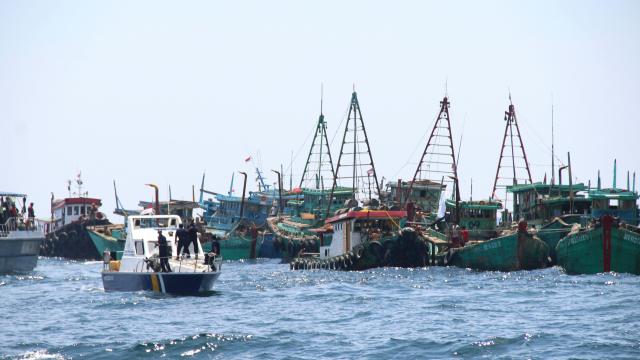Slavery is rampant on fishing vessels around the world. Just how rampant, though, is an open question, given the challenges of cataloging what happens onboard thousands of vessels that spend weeks out at a sea and move from port to port, including in countries with lax regulations.
A new study, though, aims to use satellite and machine learning to track ships that traffic laborers. The findings provide a conservative estimate that between 57,000 and 100,000 people were forced to labour on fishing vessels between 2012 and 2018. Though AI alone can’t end what the study calls a “humanitarian tragedy,” it can help start to penetrate the veil of secrecy around slave labour and end its practice on the high seas.
[referenced id=”1658533″ url=”https://gizmodo.com.au/2020/12/deteriorating-oil-tanker-threatens-the-red-sea-scientists-warn/” thumb=”https://gizmodo.com.au/wp-content/uploads/2020/12/15/fe8ap7uhjsza1ehrqqul-300×169.jpg” title=”Deteriorating Oil Tanker Threatens the Red Sea, Scientists Warn” excerpt=”An abandoned tanker carrying 1 million barrels of oil is at risk of spilling its toxic cargo into the Red Sea, a group of concerned scientists is warning.”]
The study, published in the Proceedings of the National Academy of Sciences on Monday, uses data captured from the Automatic Identification System, a satellite tracking system used to monitor ships’ movements around the world. Not all ships use them all the time — the study notes that some turn them off to reportedly avoid piracy — but those that do can allow researchers to construct a fairly comprehensive web of where ships go, when, and how they behave. The scientists took that data (including when AIS was turned off) and compared it to known cases of ships that used forced labour and interviews with experts in trafficking to train a machine learning tool that could identify ships likely reliant on trafficked labour.
The characteristics most associated with vessels at a “high risk” of exploitation included engine power as a proxy for size as well as how far out to sea they went, how often, and how long they spent fishing. The study identified ships flying the flags of China, Japan, South Korea, and Taiwan as those most likely to be exploitive. The results also showed that while vessels known to traffic in slave labour visited ports in 17 countries, the vessels identified by AI as high-risk visited an additional 64 countries.
Gavin McDonald, the lead researcher on the project from the University of California, Santa Barbara’s Environmental Markets Solutions Lab, said in an email that forced labour in the fishing industry has “been a pervasive problem that’s been very hard to shed a brighter light on. However, with new satellite-based vessel monitoring and AI, we’re now able to assess forced labour risk in a global way that was never before possible.”
That new view could open the door to new levels of enforcement at ports, including those the study identified that had high-risk vessels visit. McDonald said the research team is working to assign specific fisheries a score based on the odds of slave labour in a given region that could be used for packaging on seafood.
“Our colleagues at Global Fishing Watch are meanwhile taking this proof-of-concept model and building it out into an actionable inspection tool,” he added. The study notes that organised criminals are often behind human trafficking, and a goal of doing crimes, of course, is to not get caught. That means that AI would need to be constantly updated with the latest patterns of trafficking.
There’s also a need to address the underlying issues, on both the human and ecological sides, that can end trafficking. On the human side, it means improving economic situations that leave people in precarious positions, including creating programs for migrant workers who are often swept up in trafficking. On the conservation side, more effort needs to be put into restoring fish stocks, both to stop ecosystems from collapsing and to ensure vessels aren’t tasked with going ever farther out to sea or taking risks in search of a catch.
